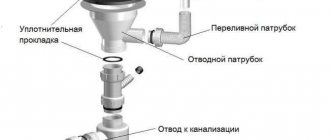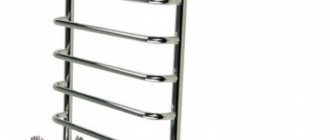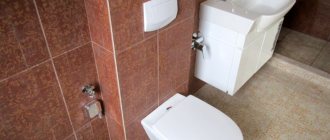Often the area and layout of the bathroom does not allow placing a heated towel rail of the desired size. To solve this problem, manufacturers have provided a range of stylish and convenient compact options.
Currently, there are a large number of different heated towel rails on the market. They differ in shape, size, type, material and, of course, price. Each model has its own advantages and disadvantages in the design and functionality of the room. What should a heated towel rail be like in a small room? And how not to make a mistake in choosing? More details from now on.
Types of heated towel rails
Types
There are two main types of heated towel rails:
- Water - they are connected directly to the hot water supply system.
- Electric - as their name implies, such heated towel rails are connected to the electrical network.
When choosing a heated towel rail for the bathroom, you should pay attention not only to the type of device, but also to factors such as the size of the heated towel rail, as well as the area of the heated room.
Forms
Heated towel rails also vary in shape. At its core, this device is a curved pipe that can have a variety of shapes. The most common forms are:
- U-shaped coils are similar to the letter P rotated 90°.
- M-shaped coils are similar to the letter M rotated 90°.
- Ladder - similar to a ladder.
- Foxtrot is a combination of two coils: an external U-shaped one and another internal one.
Foxtrots and ladders have a large heating area, which allows them to easily heat a fairly large room; in addition, they can accommodate more things to dry and dry faster due to the greater adherence of the fabric to the heated towel rail.
You can find out the corner dimensions of bathtubs in this article. And here about the sizes of cast iron bathtubs.
Material
The material from which heated towel rails are made is no less important; let’s take a closer look at them:
Steel
You won’t find such heated towel rails on sale, but in old houses, and even in some new ones, heated towel rails are simply made from an ordinary curved steel pipe. Their advantage is that they are cheap, and in addition, as practice shows, they work for years.
Stainless steel
They can withstand high pressure, are heavy, and come in chrome plated or painted in various colors. When choosing, be sure to look at the thickness of the pipe walls; they should be at least 3 mm.
Copper
High thermal conductivity, anti-corrosion resistance, lightness, appearance. When purchasing, please note that the inner surface of the pipe walls must be galvanized to maximize the protection of the pipe from water.
Brass
They have the advantages of copper heated towel rails; they are cheaper, but more fragile. When purchasing, choose heated towel rails with chrome-plated inner walls. They can be recommended for installation in autonomous heating systems.
Features of placing small heated towel rails
Small-sized heated towel rails, purely theoretically, can be placed anywhere in the room, but that was not the case. The nuances of placement depend on the type and shape of the product.
Water models depend on the distance from the main riser. Electrical from the presence and proximity of a waterproof outlet. For combined options, choosing the optimal location in a small room is almost impossible.
The shape of the heated towel rail also affects its location. Even the small size of a heated towel rail does not guarantee that its convex bars will not interfere with movement around the room. Deep models should be placed in a non-accessible place, otherwise they threaten to become a place where bruises accumulate.
Even a small bathroom can be cozy and comfortable if all the necessary elements are harmoniously selected inside. A compact heated towel rail will definitely become the center of your design, but for maximum ease of use you will have to evaluate not only the aesthetic characteristics of the product.
Heated towel rail sizes
dimensions
Different forms of heated towel rails have different dimensions. U-shaped coils are the smallest, Ladder coils are the largest:
- U-shaped coils: height 32 cm, width 40-80 cm.
- M-shaped coils: height 50-60 cm, width 40-80 cm.
- Ladder: height 50-120 cm, width 50-80 cm.
- Foxtrot: height 32-60 cm, width 40-80 cm.
Connection dimensions
Heated towel rails are available for sale with the following diameters:
- ½" - outer diameter 19 mm. Foxtrots, ladders.
- ¾" - outer diameter 25 mm. P and M-shaped coils.
- 1″ - outer diameter 32 mm. All forms.
- 1 1/4″ - Outer diameter 40 mm. U-shaped coils and foxtrots.
Heating area
Size of water heated towel rail and volume of heated bathroom:
- 50x40 cm - 4.5-6 m³
- 50x50 cm - 4.5-6 m³
- 50x60 cm - 4.5-6 m³
- 60x40 cm - 6-8 m³
- 60x50 cm - 6-8 m³
- 60x60 cm - 6-8 m³
- 80x40 cm - 7.5-11 m³
- 80x50 cm - 7.5-11 m³
- 80x60 cm - 7.5-11 m³
- 100x40 cm - 9.5-14 m³
- 100x50 cm - 9.5-14 m³
- 100x60 cm - 9.5-14 m³
- 120x40 cm - 11-17 m³
- 120x50 cm - 11-17 m³
- 120x60 cm - 11-17 m³
- 120x80 cm - 11-17 m³
Electric heated towel rail power and bathroom volume:
- 500 W – 10 m³
- 750 W – 15 m³
- 1000 W – 20 m³
- 1250 W – 25 m³
- 1500 W – 30 m³
- 1750 W – 35 m³
- 2000 W – 40 m³
At what height should you hang a heated towel rail in the bathroom?
There are standards that determine the location of equipment in the bathroom. SNiP states that the distance from the bottom pipe of the heated towel rail to the floor is at least 0.9 m, for U-shaped models - 1.2 m.
The standards were developed a long time ago and do not take into account the features of modern models. If you choose a device with a body height of 1 m, then the upper pipes in a standard room will be near the ceiling, making it inconvenient to use. The legs of the floor model are 0.6 m long and are less than the minimum distance to the floor.
For these reasons, SNiPs are perceived as recommendations. The coil is mounted in such a way that it works and is convenient to use. The last criterion is met if the device is placed at such a height that every resident of the apartment can reach it.
Before installation, place the heated towel rail against the wall and check whether it can be reached and whether other equipment is in the way. You should not place it too low - the bathroom floor is often wet.
The installation height is affected by the dimensions of the structure. When choosing equipment, take this factor into account. Small models are suitable for small rooms; in spacious rooms with high ceilings it is advisable to install long products.
Connection methods
If your choice is a water heated towel rail, then you should pay attention to the connection method, which comes in 3 types:
- Direct - the method used most often, suitable for ladders and coils.
- Bottom - used for large ladders, but requires good coolant pressure.
- Diagonal - suitable for large heated towel rails, provides effective heat transfer from the coolant, but requires a longer pipe length.
Advantages and disadvantages of heated towel rails powered by hot water
Choosing a water heated towel rail for the bathroom is not so easy. What's so complicated about that? But there are enough details and nuances that you don’t even suspect about. So, we'll have to figure it out. First, let's list the advantages and disadvantages of water models.
Some heated towel rails also serve as interior decoration.
pros
Most often in our country, water heated towel rails are installed in the bathroom. Why? They have a lot of advantages:
- Does not require additional operating costs.
- The dryer works as long as there is hot water.
- Low cost.
- Durability.
There are models that are more reminiscent of heating devices
The main advantage of a water heated towel rail is that it is installed once (correctly) and forgotten. It just exists and works. Requires almost no maintenance and is hassle-free. Replacement is usually only necessary for aesthetic reasons.
Minuses
The water heated towel rail can be connected to hot water supply or heating. In the second case, the device will only work during the heating season. When connected to a hot water supply, the “towel” works in the summer too, but its temperature depends on the water supply. If there is no movement of water, it is cold or barely warm.
In modern homes, the temperature of heated towel rails practically does not depend on the volume of water drawn. A return line is added to the hot water riser, thanks to which hot water always circulates.
In addition to large-diameter pipes supplying cold and hot water, there is a pipe of smaller diameter - this is the DHW return
One more nuance: you need to connect the device wisely, according to the correct circuit. Otherwise, due to circulation problems, the heated towel rail may be only slightly warm or even cold.
Also available in graphic version
The second disadvantage is also related to operation. If the pipes leak or burst due to water hammer, a lot of water will spill out. Everyone knows what this threatens - a very unpleasant moment. The solution is to periodically check the condition of the connections and, at the slightest sign of leaks, take adequate measures.
If you want to insure against troubles, install a leakage protection system. The most popular are “Aquaguard”, “Neptune” and “Hydrolock”.
How to determine the size of a product?
The size of the heated towel rail plays a decisive role in the choice of equipment. If you incorrectly calculate the dimensions, this will complicate installation and will not allow you to purchase equipment that will fully cope with the functions assigned to it. Experts advise taking into account the temperature of the coolant in the system. It is usually 70 degrees. This technology assumes that the ratio of the heated towel rail area to the bathroom area is 2.5 cubic meters/100 W. In addition, be sure to determine the installation location and add 10 centimeters on each side.
What criteria must be taken into account when choosing a heated towel rail?
The device can be powered by electricity or water. The latter operate on the principle of heating radiators. Electric models are easy to connect, but require good, working electrical wiring. The preferred connection method must be taken into account when purchasing. Water ones are more common because they are considered as safe as possible and can be installed even in houses and apartments with old electrical wiring. Deciding on the connection method is not difficult. It is much more difficult to choose the right shape and dimensions of the heated towel rail. The dimensions of the device must be selected taking into account the area of the room, since it takes on the “responsibilities” of a heating device.
Which heated towel rail to choose: Nika, Leroy, Sunerzha, Argo, Zehnder
In order to choose the right product, the buyer studies its various performance characteristics, determines his priorities, and consults with professionals. Sometimes you can do it much simpler by giving preference to a specific manufacturer.
Some companies have their own fans and a large number of positive reviews. After talking on numerous forums and gleaning useful information from sales consultants, we can highlight a list of popular ones (Sunerzha). The company supplies high-quality equipment to the CIS. Electric heated towel rails are made from stainless steel. Features: designer appearance of the products and a multi-stage polishing process. • "Nika". Popular Russian manufacturer. Manufacturing material – stainless steel. Heated towel rails come in a wide variety of models, with or without shelves. • Zehnder. A German company that produces any model of structure that can combine aesthetics and functionality. The main feature is the ability to apply any color coating. Powder enamel or chrome plating methods are used. • Argo. Famous Russian brand. They produce a wide range of products - from classics to design models of modern heated towel rails. High quality is confirmed by the presence of stainless steel, polymer protection inside the pipes, and ideal welded joints. • "Leroy". Wide selection of products with a decent price range. The advantages of the product are stainless steel, reliability and durability of the structures.
A good heated towel rail should be of high quality, functional, and safe. A wide variety of models from modern manufacturers allows the designs to confidently fit into any interior.
Decorative and practical functions of a heated towel rail
In the difficult conditions of a bath, where washing, cleaning, and procedures are regular, it is difficult to achieve a normal microclimate even with the help of good ventilation. And humidity is a fabulous environment for the development of colonies of microbes and mold. The metal becomes rusty and the wooden elements begin to rot. Connecting a heated towel rail prevents destructive phenomena because:
- the air is always dry;
- mold and rot are afraid of dry conditions;
- equipment and furniture last longer.
A heated towel rail can play the role of an important decorative element in the bathroom interior
In addition to establishing a comfortable temperature and the ability to dry things, this is also a wonderful decor, since the design of modern radiators is charming.
Floor dryer made of brass pipes
Modern bathroom with frame-type heated towel rails
General recommendations for choosing a heated towel rail
To select a plumbing fixture that will fully meet the assigned functions, the following criteria should be taken into account:
- fastening method;
- material of manufacture;
- connection size and shape of the heated towel rail;
- the size of the bathroom and the location where the device is planned to be installed.
It is impossible to single out any specific version of the heated towel rail. The choice must be made on an individual basis. Many criteria should be taken into account, including the sufficient amount of heat generated by the device. Otherwise, it will not be possible to heat the room. Another important nuance is the weight of the heated towel rail. A plasterboard wall, for example, cannot withstand any load. To avoid force majeure situations, they calculate not only the optimal size, but also the weight of the future plumbing fixture. There is no need to calculate this parameter yourself. Weight is indicated in the accompanying documentation.
How to correctly take into account the connecting size of the device?
Individual construction allows you to install a pipeline to connect a heated towel rail of the desired shape. In apartments, this option requires significant financial investments, but is often practiced when carrying out major renovations. The size directly depends on the shape of the device.
The most widespread are universal heated towel rails in the form of a coil, since they are manufactured according to generally accepted connection standards. Ladders and foxtrots also have close to standard parameters, which is why they are popular among consumers. When choosing a standard size, you should take into account such a parameter as the “conditional bore diameter” or the internal net size of the pipeline. It is always one size smaller than what is indicated in the classification. If you take a model with a connection of type “1”, the nominal diameter is “3/4”. This must be taken into account. Otherwise, you may encounter the fact that the purchased heated towel rail will not fit the pipeline.











